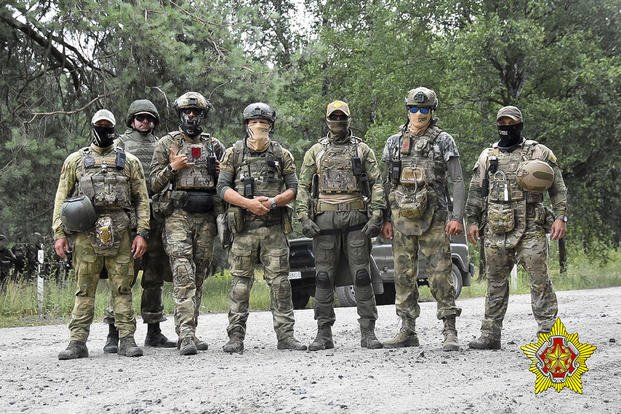An eyebrow-raising situation emerged with Belarusian special forces partaking in training exercises conducted by Russia’s Wagner Group mercenaries, deliberately selecting a military range within close proximity to NATO’s Poland border.
Thursday proved eventful as the Belarusian defense ministry brought forth this disclosure, following Wagner’s chief, Yevgeny Prigozhin, extending a warm reception to his fighters in Belarus only a day earlier.
Prigozhin’s definitive instructions dictated that his fighters should temporarily withdraw from the Ukraine war and focus their energies on gearing up for African endeavors, all while being engaged in training the Belarusian army.
‘The armed forces of Belarus continue joint training with the fighters of the Wagner PMC (Private Military Company),’ the Belarusian defence ministry said.
‘During the week, special operations forces units together with representatives of the Company will work out combat training tasks at the Brest military range.’
The military range’s location, only 3 miles (5 km) to the east of the Polish border, adds an element of uncertainty around the unfolding events.
Read also: We Are Tracking Movements Of Wagner Mercenaries – NATO
Staying true to the secrecy demanded by the mercenary group, masked Wagner instructors were photographed during their training sessions with Belarusian soldiers. The images portrayed them maneuvering armored vehicles and seemingly overseeing drone controls.
‘Despite the rain, it’s hot at the Brestsky training ground,’ the Belarusian defence ministry noted in a statement, releasing pictures of masked fighters in combat gear.
A deal of paramount importance in mitigating the revolt that had become the most formidable test to President Vladimir Putin’s authority, involved the relocation of Wagner fighters and their leader to Belarus.
Having played a crucial part in the Ukraine offensive, Wagner initiated a high-stakes plan to overthrow Russia’s military leadership during a brief but intense rebellion last month, eventually choosing to de-escalate the situation.
In a surprising move, Alexander Lukashenko, the strongman leader of Belarus, made a generous offer of refuge to Yevgeny Prigozhin, the head of Wagner.
Lukashenko also highlighted the advantageous prospect of having Wagner commanders contribute their combat experience to enhance the capabilities of the Belarusian army.
Last week, Minsk disclosed that the defense ministry and Wagner had forged a crucial ‘road map’ to foster knowledge exchange, leading to instructors embarking on training territorial defense forces.
On a Wednesday evening, a video emerged, alleging to portray Prigozhin addressing his fighters in Belarus. This marked the initial footage of the enigmatic mercenary chief after the rebellion’s failure.
Prigozhin’s words were captured in a video shared by Telegram channels associated with Wagner, where he revealed his fighters’ plan to remain in Belarus ‘for some time’. They were determined to play a role in elevating the country’s army to be recognized as the ‘second army in the world.’
‘What’s happening at the front is a disgrace in which we don’t need to take part,’ Prigozhin said, noting that Wagner could proceed to the front later.
Citing the presence of Wagner mercenaries in Belarus, the Polish defense ministry declared its intent to reinforce security at the border.
Two Polish brigades have been reassigned to positions along the border, as confirmed by the defense ministry.

